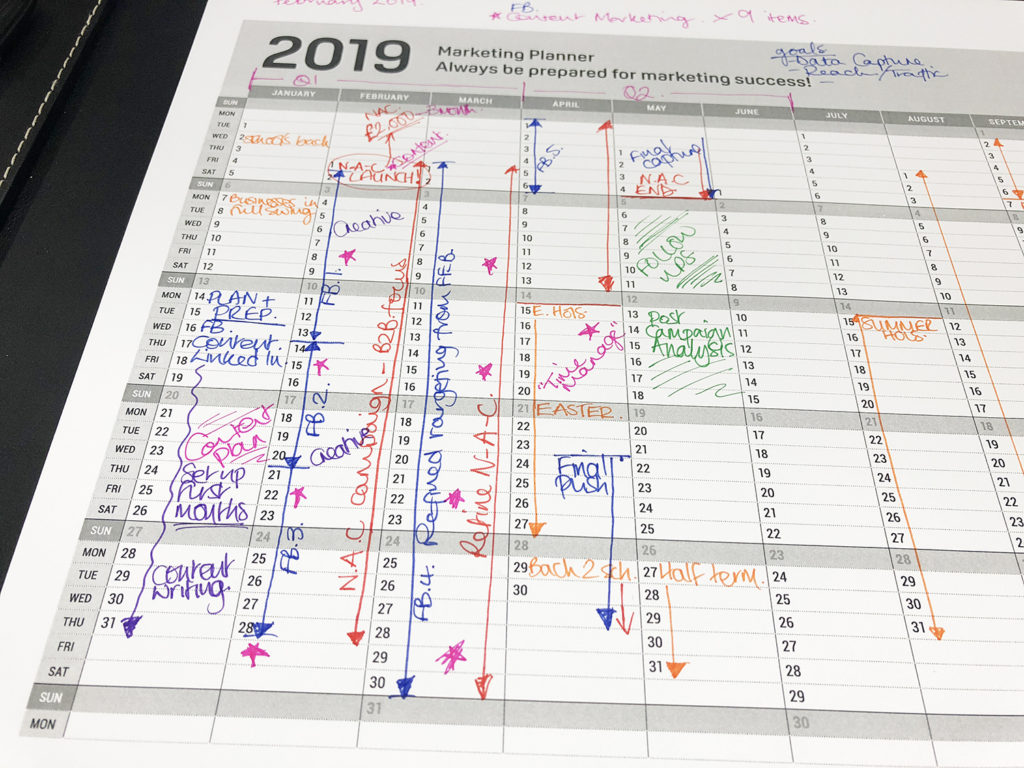How many times have you haphazardly thrown together a quick emailer announcing a last-minute sale? Or dabbled at Facebook ads, only to be put off by little success or the time it takes to set up?
Marketing your business is a hefty job that takes years of trial and error. You may, in fact, only ever have time to do everything last minute and never really feel like you’re ever on top of it.
What if I told you that we, as a team of four people, manage to plan, create and implement full marketing strategies for over twenty (and growing) businesses on a continual basis.
And most importantly, we get real results.
If we can juggle and successfully implement that many strategies, then you can do it for your business. It’s all about planning ahead and managing your time in an efficient way. Half the battle with a marketing strategy is the planning ahead part. You can get ahead with the intention of staying ahead, but before you know it you are back to fighting those last-minute demons.
So, what is a marketing strategy? Simply put, it’s a plan with a goal. We can split a strategy in to five steps:
- Plan
- Budget
- Create
- Implement
- Refine
…And it’s all held together with goals, targeted at specific audiences.
Step 1: The plan
Start at a 12-month plan. Mark down on a big calendar (we’re talking wall chart size! The bigger the better) all the periods of the year that are likely to affect sales, positively or negatively. Think about school holidays, Christmas, Black Friday, seasons, trends… everything possible.
Use a different coloured pen and clearly mark on weeks where you can run promotional campaigns to coincide with these periods.
In another pen colour, block days/weeks where you will run advertising – across print and digital. Think about every possible avenue and don’t be afraid to add as many marketing opportunities as possible. Don’t forget Facebook advertising, pay-per-click, emailers, direct mail and other relevant advertising.
Whichever avenues you choose, (note an emphasis on the plural there… never rely on one single avenue of marketing), it’s essential to keep key messages consistent across each.
Make sure print adverts are ready for deadlines too (print ads in magazines, for example, can be weeks in advance of publication). Keep a track of all deadlines and publication dates – and makes sure your digital ads are coinciding with these dates too. Mark EVERYTHING on your campaign calendar.

(This is how my marketing plan starts – a colourful mess! It allows me to brainstorm and think about every possible outlet for our campaigns. It’s as much about brainstorming as it is planning).
Step 2: Marketing Budget
How much do you spend on marketing? As a rule of thumb, a small business should be spending between 5 – 10 percent of their revenue on marketing. Start by calculating your maximum budget and then correlate it to the marketing plan.
If you need marketing assets creating, ie. Graphics, videos, print materials etc, make sure that you get quotes first and incorporate that in to the spend.
Only you can define how much to spend on each form of marketing. It takes trial and error to understand the needs of your marketing and efficient use of your budget.
Step 3: Create
Campaign assets should be ready to go well in advance of implementing your campaigns. Many large companies will have their Christmas promotions all prepared and ready to go in the height of summer.
All assets should work together through the different avenues of marketing, each with their own goals and objectives.
It would be easy to simply create a poster, image or graphic and then use that exact image across the board. But what works on a Facebook click-through ad won’t look right as a Mailchimp header, for example. Nor would a Facebook cover photo work on a carousel ad. Every asset needs to be created individually to the dimensions required.
Once your promotional collateral is ready, it’s time to write the copy and set up the advertising parameters.
Step 4: Implement
Implementation and getting all campaigns moving is the bit that needs a huge amount of attention to detail to make sure everything is correct. Timings and set-up also need to be accounted for in the planning stage.
A full campaign of multiple Facebook ads can end up taking hours to set up – so do not leave them to the last minute. This is where deadlines tend to get missed because the implementation stage takes longer than expected.
You should already have a good idea of the audiences you need to target. However, the first stage of implementation should be the learning stage and understanding how your audiences are going to respond to the various promotions.
Never implement a campaign with a ‘catch-all’ mentality. Trial different audiences for different ads, being specific with exactly the type of customer you want to target.
This is where Facebook becomes an essential marketing tool, not just for ad delivery, but for audience analytics. Create split tests to target three different audiences, using a database of people who have already bought from you – or target people who are in the market for your product, for example.
Step 5: Refine
Split your marketing strategy in to two parts: Testing and refinement. The testing stage is where you learn what works and what doesn’t. There’s no such thing as a failed campaign, so long as you plan the campaign to allow for testing.
Facebook also “learns” what works, the more audience parameters you test, the more it learns who the right people to target are.
Monitor the campaign and make adjustments. If a digital campaign isn’t producing the results you’d hoped for within the first few days then you can stop and start again without losing budget.
Do not let a campaign run for the full duration without monitoring.
Post Campaign Analysis
The more you properly plan and implement a marketing strategy, the more you will be able to refine the process down. Half the battle is planning well in advance and scheduling the time to do the leg work.
If you are outsourcing any elements of marketing, this stage is crucial to ensure all parties are working to schedule.
Sound like too much work? For more information about how we can help with your marketing strategy, get in touch with our experts.




